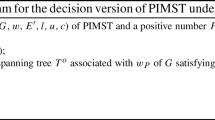Abstract
As far as we know, for most polynomially solvable network optimization problems, their inverse problems under l 1 or l ∞ norm have been studied, except the inverse maximum-weight matching problem in non-bipartite networks. In this paper we discuss the inverse problem of maximum-weight perfect matching in a non-bipartite network under l 1 and l ∞ norms. It has been proved that the inverse maximum-weight perfect matching under l ∞ norm can be formulated as a maximum-mean alternating cycle problem of an undirected network, and can be solved in polynomial time by a binary search algorithm and in strongly polynomial time by an ascending algorithm, and under l 1 norm it can be solved by the ellipsoid method. Therefore, inverse problems of maximum-weight perfect matching under l 1 and l ∞ norms are solvable in polynomial time.
Similar content being viewed by others
References
R.K. Ahuja and J.B. Orlin, “A faster algorithm for the inverse spanning tree problem,” J. of Algorithms, vol. 34, pp. 177-193, 2000.
R.K. Ahuja and J.B. Orlin, “Inverse optimization,” Operations Research, vol. 49, pp. 771-783, 2001.
C. Berge, “Two theorems in graph theory,” in Proceedings of National Acadamy of Sciences, USA, vol. 43, pp. 842-844, 1957.
D. Burton and PhL. Toint, “On an instance of the inverse shortest paths problem,” Mathematical Programming, vol. 53, pp. 45-61, 1992.
M. Cai and Y. Li, “Inverse matroid intersection problem,” Mathematical Methods of Operations Research, vol. 45, pp. 235-243, 1997.
M. Cai, X. Yang, and J. Zhang, “The complexity analysis of the inverse center location problem,” Journal of Global Optimization, vol. 15, pp. 213-218, 1999.
J. Edmonds, “Maximum matching and a polyhedron with 0-1 vertices,” J. Res. Natl. Bur. Stand., vol. 69B, pp. 125-130, 1965.
Z. Hu and Z. Liu, “A strongly polynomial algorithm for the inverse shortest arborescence,” Discrete Applied Mathematics, vol. 82, pp. 135-154, 1998.
S. Huang and Z. Liu, “Inverse problem of minimum cost flow,” in Advances in Operations Research and Systems Engineering, J. Gu, et al. (Eds.), Global Publishing Co., Hong Kong, 1998.
E.L. Lawler, Combinatorial Optimization: Networks and Matroids, Holt. Rinehart and Winston, New York, 1976.
C.H. Papadimitriou and K. Steiglitz, Combinatorial Optimization: Algorithms and Complexity, Prentice-Hall, Englewood Cliffs, NJ, 1982.
Q. Wei, J. Zhang, and X. Zhang, “An inverse DEA model for inputs/outputs estimation,” European Journal of Operational Research, vol. 121, pp. 151-163, 2000.
S. Xu and J. Zhang, “An inverse problem of the weighted shortest path problem,” Japan Journal of Industrial and Applied Mathematics, vol. 12, pp. 47-59, 1995.
C. Yang and J. Zhang, “Inverse maximum flow and minimum cut problems,” Optimization, vol. 40, pp. 147-170, 1997.
C. Yang and J. Zhang, “Inverse maximum capacity problem,” Operations Research Spektrum, vol. 20, pp. 97-100, 1998.
C.Yang and J. Zhang, “Aconstrained capacity expansion problem on networks,” International Journal of Computer Mathematics, vol. 70, pp. 19-33, 1998.
C. Yang and J. Zhang, “Two general methods for inverse optimization problems,” Applied Mathematics Letters, vol. 12, pp. 69-72, 1999.
J. Zhang and M. Cai, “Inverse problem of minimum cuts,” Mathematical Methods of Operations Research, vol. 48, pp. 51-58, 1998.
J. Zhang and Z. Liu, “Calculating some inverse linear programming problems,” J. Computational and Applied Mathematics, vol. 72, pp. 261-273, 1996.
J. Zhang and Z. Liu, “A further study on inverse linear programming problems,” J. Computational and Applied Mathematics, vol. 106, pp. 345-359, 1999.
J. Zhang, Z. Liu, and Z. Ma, “On inverse problem of minimum spanning tree with partition constraints,” Mathematical Methods of Operations Research, vol. 44, pp. 347-358, 1996.
J. Zhang, Z. Liu, and Z. Ma, “Inverse fractional matching problem,” The Journal of Australia Mathematics Society, Ser. B: Applied Mathematics, vol. 40, pp. 484-496, 1999.
J. Zhang, Z. Ma, and C. Yang, “A column generation method for inverse shortest path problem,” Mathematical Methods of Operations Research, vol. 41, pp. 347-358, 1995.
J. Zhang and Z. Ma, “A network flow method for solving inverse combinatorial optimization problems,” Optimization, vol. 37, pp. 59-72, 1996.
J. Zhang and Z. Ma, “Solution structure of some inverse optimization problems,” Journal of Combinatorial Optimization, vol. 3, pp. 127-139, 1999.
J. Zhang, S. Xu, and Z. Ma, “An algorithm for inverse minimum spanning tree problem,” Optimization Methods and Software, vol. 8, pp. 69-84, 1997.
Author information
Authors and Affiliations
Rights and permissions
About this article
Cite this article
Liu, Z., Zhang, J. On Inverse Problems of Optimum Perfect Matching. Journal of Combinatorial Optimization 7, 215–228 (2003). https://doi.org/10.1023/A:1027305419461
Issue Date:
DOI: https://doi.org/10.1023/A:1027305419461




